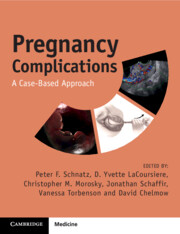Book contents
- Pregnancy Complications
- Pregnancy Complications
- Copyright page
- Contents
- Contributors
- Preface
- Note from the Editor-in-Chief
- Normal Laboratory Values (Conventional Units) []
- Section 1 Antepartum (Early Pregnancy)
- Case 1 A Patient of Ashkenazi Jewish Ancestry Presents for Preconception Counseling
- Case 2 A Patient with a Subchorionic Hematoma Presents with Early Vaginal Bleeding
- Case 3 A 25-Year-Old with a Twin Gestation at 9 Weeks
- Case 4 A 35-Year-Old with HSIL Cervical Cytology at 10 Weeks
- Case 5 A 20-Year-Old with a Molar Pregnancy at 8 Weeks
- Case 6 A 20-Year-Old with Anxiety and Depression at 7 Weeks
- Case 7 A 40-Year-Old with Nausea, Vomiting, and Weight Loss at 7 Weeks
- Case 8 A 30-Year-Old with Worsening Migraine Headaches at 14 Weeks
- Case 9 A 30-Year-Old with Isoimmunization at 9 Weeks
- Case 10 A 25-Year-Old with an Early Pregnancy and Bicornuate Uterus
- Case 11 Recommended Vaccinations at an 8-Week Prenatal Intake
- Section 2 Antepartum (Mid-trimester)
- Section 3 Antepartum (Late Pregnancy)
- Section 4 Antepartum (Medical Complications)
- Section 5 Antepartum (Infectious Complications)
- Section 6 Intrapartum/Delivery
- Section 7 Postpartum
- Section 8 Fetal Complications
- Section 9 Placental Complications
- Section 10 Complications of the Cord, Amnion, and Gravid Uterus
- Section 11 Psychosocial Considerations
- Index
- References
Case 7 - A 40-Year-Old with Nausea, Vomiting, and Weight Loss at 7 Weeks
from Section 1 - Antepartum (Early Pregnancy)
Published online by Cambridge University Press: 08 April 2025
- Pregnancy Complications
- Pregnancy Complications
- Copyright page
- Contents
- Contributors
- Preface
- Note from the Editor-in-Chief
- Normal Laboratory Values (Conventional Units) []
- Section 1 Antepartum (Early Pregnancy)
- Case 1 A Patient of Ashkenazi Jewish Ancestry Presents for Preconception Counseling
- Case 2 A Patient with a Subchorionic Hematoma Presents with Early Vaginal Bleeding
- Case 3 A 25-Year-Old with a Twin Gestation at 9 Weeks
- Case 4 A 35-Year-Old with HSIL Cervical Cytology at 10 Weeks
- Case 5 A 20-Year-Old with a Molar Pregnancy at 8 Weeks
- Case 6 A 20-Year-Old with Anxiety and Depression at 7 Weeks
- Case 7 A 40-Year-Old with Nausea, Vomiting, and Weight Loss at 7 Weeks
- Case 8 A 30-Year-Old with Worsening Migraine Headaches at 14 Weeks
- Case 9 A 30-Year-Old with Isoimmunization at 9 Weeks
- Case 10 A 25-Year-Old with an Early Pregnancy and Bicornuate Uterus
- Case 11 Recommended Vaccinations at an 8-Week Prenatal Intake
- Section 2 Antepartum (Mid-trimester)
- Section 3 Antepartum (Late Pregnancy)
- Section 4 Antepartum (Medical Complications)
- Section 5 Antepartum (Infectious Complications)
- Section 6 Intrapartum/Delivery
- Section 7 Postpartum
- Section 8 Fetal Complications
- Section 9 Placental Complications
- Section 10 Complications of the Cord, Amnion, and Gravid Uterus
- Section 11 Psychosocial Considerations
- Index
- References
Summary
Hyperemesis gravidarum is considered the severe end of the spectrum of nausea and vomiting of pregnancy. While there is no agreed upon strict definition for this condition, the criteria include persistent vomiting not related to other causes, a measure of acute starvation, and documented weight loss, most often at least 5% of pre-pregnancy weight. Electrolyte, thyroid, and liver abnormalities also may be present. The incidence of hyperemesis gravidarum is approximately 0.3–3% of pregnancies, but the reported incidence varies because of different diagnostic criteria and ethnic variation in study populations. Risk factors include patients with increased placental mass (molar gestation or multiple gestation), a history of motion sickness, migraine headaches, a family history, and a history of hyperemesis gravidarum in a previous pregnancy. Daughters and sisters of patients who had hyperemesis gravidarum are more likely to have the same condition, as are patients carrying a female fetus. The workup involves ruling out other causes, and the treatment focuses on relieving symptoms and preventing serious morbidity. Hyperemesis gravidarum can significantly impact the quality of life of patients and their families and may be challenging to treat.
Keywords
- Type
- Chapter
- Information
- Pregnancy ComplicationsA Case-Based Approach, pp. 19 - 21Publisher: Cambridge University PressPrint publication year: 2025

